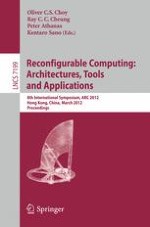2012 | Book
Reconfigurable Computing: Architectures, Tools and Applications
8th International Symposium, ARC 2012, Hong Kong, China, March 19-23, 2012. Proceedings
Editors: Oliver C. S. Choy, Ray C. C. Cheung, Peter Athanas, Kentaro Sano
Publisher: Springer Berlin Heidelberg
Book Series : Lecture Notes in Computer Science
